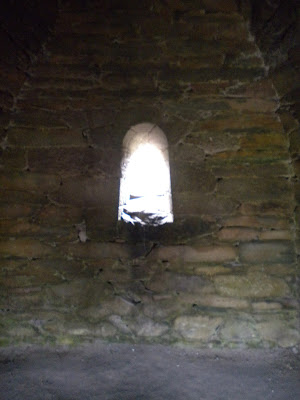No, we didn't go back to Ireland for a second trip this year-- this post is out of chronological order-- I discovered I had not completed this last draft for Ireland, and just now finished it. Sorry for the confusion, but this old stone building is incredible-- had to share. [JK]
Flying over Ireland it appears as patchwork of fields, squared off by boundaries of what appears to be hedges and shrubs. Upon closer inspection from the ground you discover that the fencing are rock walls or dykes, with an overgrowth of grass and shrubs. In more barren areas they are clearly stacked stones. Despite the abundance of stone available, it is mind boggling to consider how long it must have taken to construct so many field enclosures of stone.Many of the earliest structures and dwellings were constructed of stone, and over the ages the stones of ancient structures were probably "borrowed" to construct new ones, or create the pasture walls. It is therefore amazing that some of the ancient structures have withstood the passage of time. One structure, the Gallerus Oratory is one of the best preserved examples of this type of structure. The Oratory or Séipéilín Ghallarais (The church of the place of the foreigners) was built sometime between the sixth and ninth centuries, possibly as late as the twelth century, and believed to be an early Christian church. The construction technique, known as corbel vaulting, is a marvel-- dry-layed stones, with no mortar, and tiered to form a roof. The rocks are also positioned and angled so carefully that the inside of the structure is bone dry, even to this day.
Flying over Ireland it appears as patchwork of fields, squared off by boundaries of what appears to be hedges and shrubs. Upon closer inspection from the ground you discover that the fencing are rock walls or dykes, with an overgrowth of grass and shrubs. In more barren areas they are clearly stacked stones. Despite the abundance of stone available, it is mind boggling to consider how long it must have taken to construct so many field enclosures of stone.Many of the earliest structures and dwellings were constructed of stone, and over the ages the stones of ancient structures were probably "borrowed" to construct new ones, or create the pasture walls. It is therefore amazing that some of the ancient structures have withstood the passage of time. One structure, the Gallerus Oratory is one of the best preserved examples of this type of structure. The Oratory or Séipéilín Ghallarais (The church of the place of the foreigners) was built sometime between the sixth and ninth centuries, possibly as late as the twelth century, and believed to be an early Christian church. The construction technique, known as corbel vaulting, is a marvel-- dry-layed stones, with no mortar, and tiered to form a roof. The rocks are also positioned and angled so carefully that the inside of the structure is bone dry, even to this day.
 |
Gallerus-- Isabelle gives a good perspective on the size of the Gallerus Oratory, a stone building erected sometime between the 6th and 12th centuries. The Oratory is near the village of Ballidavid. |
Further down the road along the coast towards Dingle are several ring forts (at least two). One of these has the remnants of buildings similar to the Gallerus Oratory, called the Beehive Huts. It is difficult to imagine life in this structures-- they appear to be little more than human constructed caves. However they apparently provided the clan that inhabited them some safety and protection from marauding enemies.






No comments:
Post a Comment